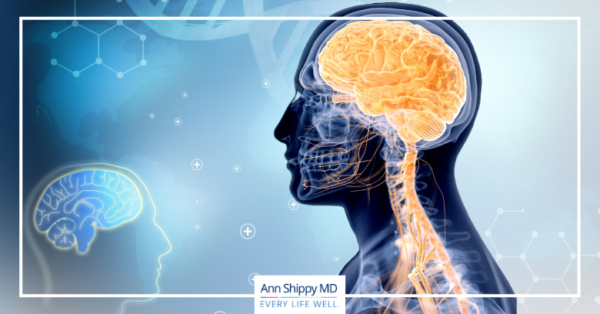As a Functional Medicine physician, I’m always looking at the root cause and interested in how not only to help my patients heal but to help them thrive.
As much as I emphasize optimizing diet, restoring nutritional deficiencies, reducing toxicity, and adopting positive habits – stress often plays an important role in chronic disease and symptoms too. Often stress is the last place where people make a change because it can be harder and require more dedication than popping a pill or hitting the gym. It also means that we have to really take a look at our relationship to stress and desire to make a change at a deeper level. Today I want to talk about how stress affects the brain, specifically the limbic system, and how this can be contributing to symptoms and disease, but also allow for incredible healing.
In this article, you will learn:
- What is the limbic system and what is its function?
- Limbic system disorders – the “limbic loop”
- How to get “unstuck “ from the limbic loop by
- Retraining the limbic system
- Diet and supplement suggestions
The Limbic System – What Does The Limbic Brain Do?
The limbic system refers to the structures of the midbrain that include the amygdala, hypothalamus, hippocampus and the cingulate cortex. The limbic system is also known as the “feeling and reacting brain.” Its job is to keep you safe. I think of it as a security system for your body. The limbic system is responsible for gathering information about your present environment, determining if there is a threat and then signaling for the immune system, hormones, or nervous system to respond appropriately. The limbic system includes aspects of memory and emotional intelligence.
This system works well for occasional stressors. However, what about the stress that we face on a daily basis in our modern world? What many people don’t realize about the limbic system is that it can easily get caught in a destructive loop that contributes to symptoms and disease.
The Limbic Loop
I use the term “limbic loop” to refer to limbic system dysfunction or the chronic stress response. When I say stress, you are likely thinking of financial, relationship, or job-related stress or the stress of losing a loved one. These acute stressors definitely play a role. But when we are thinking of the limbic system, it is also affected by less obvious stressors from toxin exposure, from infections, and even past traumas.
Here are the things that I’ve seen clinically that negatively impact the limbic system:
- Chemicals – including those found commonly in cleaning products, personal care items, plastics and food, mattresses, and furniture
- Heavy metals – including lead, mercury, and cadmium
- Environmental toxins – including mold and harmful algal blooms
- Infections – viruses, bacterial or fungal infections, including common gut dysbiosis (microbial imbalance)
- Inflammatory diet – including a diet high in sugar or eating foods you are sensitive to
- EMF (electromagnetic field) exposure
- Less obvious stressful life events or situations
- Physical, sexual, or emotional trauma
These exposures and stressors create a brain response that is stuck in survival mode. What begins to happen is that you can become hypersensitive and begin reacting to stimuli that you wouldn’t normally react to. The limbic system starts interpreting seemingly everything as a stressor. Everything seems unsafe.
This is the limbic loop. The brain is literally stuck in a loop of threat.
You may begin to feel hyper-alert, vigilant, and “on.” You may find it hard to relax and have the feeling that something isn’t quite right. You may become very reactive to stress, chemicals, foods, scents, and your environment.
When the limbic system is impaired and not functioning properly, it flows downstream to all other body systems. The result can be immune system dysfunction, poor digestion, impaired detoxification, mood changes, memory changes, and more. In my practice, I see many patients affected by chronic disease and chemical sensitivities.
These results are often the snowball effect of environmental toxicity. The body, via the limbic system, is trading short-term survival for long-term wellness.
Does this sound like you? Try this helpful quiz from Dynamic Neural Retraining System, which I discuss below, to help with the assessment of limbic loops.
How To Get Unstuck
The good news is that the brain has the ability to change and essentially rewire. This is called neuroplasticity and explains why some people can recover after brain injury and stroke. Neuroplasticity also allows for retraining the limbic system to optimize function, which can reduce the sensitivity of the stress response. Often, coupling this treatment with my core Functional Medicine approaches, addressing the limbic loop can make a huge difference.
We can use important lifestyle tools to de–stress, re-train the brain to be more relaxed, and nudge the nervous system to respond in a balanced parasympathetic mode, instead of being in a fight or flight pattern. Here are some of my favorite tools that I often recommend to my patients.
Lifestyle Tools For Limbic Retraining
- DNRS, or Dynamic Neural Retraining System, is a program founded by Annie Hopper to use the science of neuroplasticity to retrain the brain patterns associated with toxicity and chronic disease. This program includes a 14-hour program (live or online) and then dedicating 1 hour per day to specific limbic brain exercises for at least 6 months. What I love about this program is that it is non-invasive and there are no side effects. It takes some time for the brain to heal, but the success stories are inspiring.
- ANS Rewire is an online program by Dan Nueffler that I became aware of more recently. Take a look and see if it appeals to you. I learned about it from a patient who really benefitted from the training.
- Muse is a favorite device for meditation and neurofeedback that helps to reset the limbic state. Neurofeedback refers to measuring and interpreting brain waves to teach self-regulation of brain function. Muse uses EEG (electroencephalogram) signal, in the form of a headband-like device, to provide you with real-time feedback and information about your mental state. When your mind is calm, you’ll hear sounds of peaceful weather, but when your mind is busy or stressed, you’ll hear stormy weather which can cue you to return to your breath, making it the perfect companion for meditation. The Muse device syncs with the Muse app, which provides you with data and helps you track progress toward a more calm and stress-free nervous system. I use the Muse myself, and it helped me at a very difficult time in my own health recovery. I often hear wonderful feedback on the muse from my patients.
- Ziva, created by Emily Fletcher, a former Broadway star, offers online courses that teach you to meditate. The Ziva Technique combines mindfulness, meditation, and manifesting to help you reduce stress, reduce pain, sleep better and increase productivity. Emily’s approach makes meditation accessible and easy to implement. Meditation supports the whole brain, including the limbic system, and allows the brain to regenerate cells. Meditation has become an essential part of my personal wellness plan and a program I frequently recommend to patients.
- 40 Years of Zen is a high-end program offered by bio–hacking expert and Bulletproof founder, Dave Asprey. This is a 5-day, intense training where you learn and practice neurofeedback in a sensory-deprivation environment to effectively train specific brainwaves. You’ll receive a customized protocol along with Bulletproof Diet meals (which fits into my Paleo recommendations minus some ghee) and supplements. The program is geared toward accelerating access to the benefits of meditation and neurofeedback to increase performance, improve relationships and reduce stress, all of which can be helpful and supportive for the limbic brain. I’ve noticed an improvement in all these areas from attending.
Diet And Supplements
In my practice, I use diet as a foundation for healing and helping the body break the limbic loop cycle. My Paleo diet supports the limbic brain and hormonal systems of the body, including the adrenal glands that are responsible for stress hormones. This dietary strategy removes the most inflammatory foods including grains, dairy, sugar, and processed foods while focusing on the most nutrient-dense veggies, meats, and fats, which in turn can reduce inflammation in the brain and provide the nutrition needed for optimal limbic function. My Paleo diet also supports detoxification, digestion, and metabolism.
Further, my Paleo diet is a moderate carbohydrate approach. For some, going too low in carbohydrates (such as on a strict Keto diet) can add stress to the body that the brain perceives as already under stress. I’ve found moderate whole food carbs from fruits and starchy veggies like sweet potatoes help to support and heal imbalances in hormones. Interestingly, there is a subsection of patients who seem to do better on a very low carb version of Paleo and experience less anxiety and better health results. The bottom line is that I start with a template and then personalize the dietary approach for each individual patient. Diet changes are also going to work the best in conjunction with stress reduction strategies.
To further support the body and healing the limbic system dysfunction, I often recommend supplements. Here are some of the common ones I use in my practice:
- Daily Probiotics help to support the gut-brain axis and support overall health.
- Glycine is an amino acid that is calming and can help to support brain health and provide neurotransmitter support.
- Stress Manager is an herbal combination formula that also contains L-theanine that can help to calm the body and reduce the stress hormone, cortisol.
- Magnesium Glycinate provides the essential mineral magnesium (in combination with glycine) that helps to calm the nervous system and release tension from the muscles. I find that most of my patients are deficient in magnesium and benefit from this supplement to help with detoxification, anxiety, and overall body function.
Effectively addressing the limbic loop could really be the missing piece for many people to heal, feel better and return to living their happiest lives. I hope this article gives you some tools and ideas on your own healing journey. If you would like to join me for a deeper dive, learn more here about the Every Life Well® Cleanse Intensive program.















